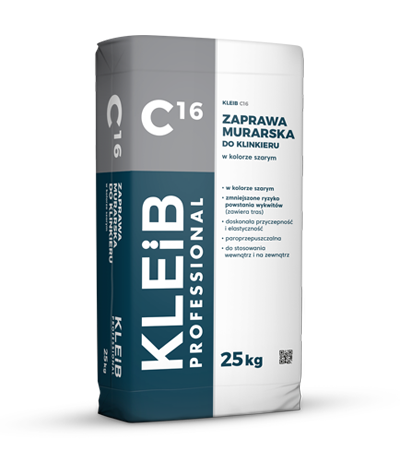MASONRY MORTAR FOR CLINKER
KLEIB C16 KLEIB C16 is a grey and graphite-coloured masonry mortar for building structural and non-structural elements made of
clinker bricks, such as: walls, fences, chimneys, etc. It is also suitable for grouting façade tiles and clinker bricks
(provided that KLEIB C16 is also used for bricklaying). The maximum width of the joint must not exceed 30 mm. Thanks
to the trass content, it is resistant to the formation of various types of efflorescence. For interior and exterior use.
- grey and graphite
- reduced risk of efflorescence (contains trass)
- excellent adhesion and resilience
- vapour permeable
- for interior and exterior use
- hydrophobic

25 kg
54
12 cm approx. 35 kg/m² of dry mortar with approx. 10 mm thick joint, 25 cm approx. 100 kg/m² of dry mortar with approx. 10 mm thick joint
CALCULATE CONSUMPTIONKLEIB C16 is a grey and graphite-coloured masonry mortar for building structural and non-structural elements made of clinker bricks, such as: walls, fences, chimneys, etc. It is also suitable for grouting façade tiles and clinker bricks (provided that KLEIB C16 is also used for bricklaying). The maximum width of the joint must not exceed 30 mm. Thanks to the trass content, it is resistant to the formation of various types of efflorescence. For interior and exterior use.
The mortar is prepared by pouring dry mix into a container with a measured amount of water and mixing until a smooth, uniform consistency is obtained. The mortar is ready to use after 5 minutes and after remixing. Prepared mortar is to be used within approx. 2 hours. The mixing ratios set forth in the technical specifications apply to masonry work. In case of grouting the amount of water should be smaller.
KLEIB C16 should be applied on the brick elements with a trowel and lightly pressed; observe traditional rules of bricklaying technology. If the mortar is used for joint sealing, work may begin minimum two weeks after the end of bricklaying or tile bonding. Clean the surfaces from dust, dirt and mortar remains and moisten them with water. Fill the joints thoroughly with mortar pressing it firmly into place. Immediately remove dry any soiling on the face surfaces. Maintain the same proportions of water throughout the bricklaying or joint sealing period. Tools should be washed with water immediately after use.
| Brickwork thickness (made of full brick) | Dry mortar consumption with the joint thickness of approx. 10 mm |
| 12 cm | approx. 35 kg/m2 |
| 25 cm | approx. 100 kg/m2 |
The mortar must be transported and stored in tightly sealed bags, in dry conditions (preferably on pallets). The shelf life is up to 12 months from the manufacturing date on the packaging.
